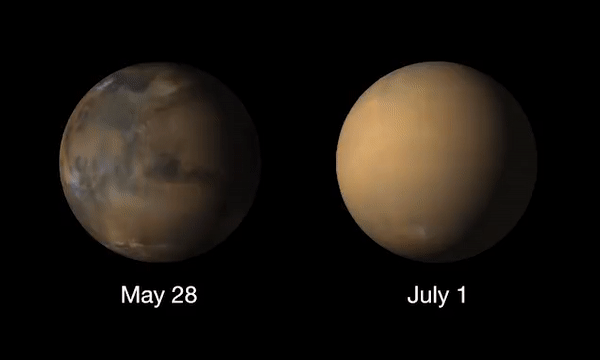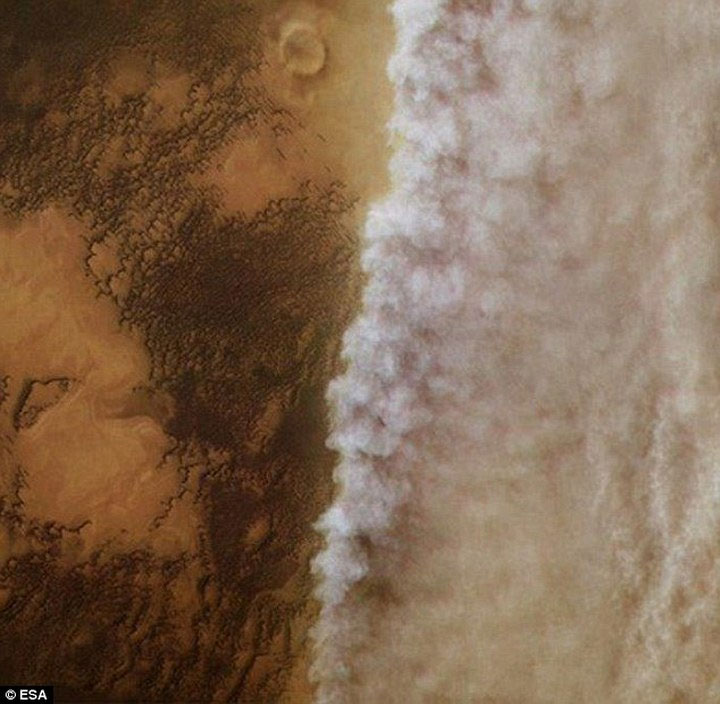The appearance of Mars suddenly changed completely after the dust storm
Covering the entire surface of Mars makes satellite images of the Red planet completely changed. It is expected that this dust storm may last until the end of September.
Every 6-8 years, large-scale dust storms appear and cover the entire surface of Mars. And this year, NASA's Mars probe detected abnormal changes on the same cycle.
Scientists first witnessed small-scale dust storms from the end of May 2018, but by June 20, dust storms had invaded the entire Red planet.

The surface of the current Mars is almost covered by a solid earthy brown color.
In NASA's latest satellite image, the current Martian surface is almost covered by a solid earthy brown color. As previously analyzed, dust storms on the Martian surface can greatly affect the Opportunity probe, because dust obscures and reduces the ability to receive energy from sunlight.
Now scientists have turned to hibernation to protect the battery. As expected, this terrible dust storm will last until at least September 2018.
Michael Smith, a scientist at NASA's Goddard Space Center, said: "This is one of the biggest weather events we've ever observed on Mars since we started to understand the universe. 1960s ".
Smith and other scientists are now trying to figure out what mechanism causes small dust storms to spread throughout the planet. In addition, they also sought to record Mars's air temperature data. This may be the leading cause of the change in wind direction, thereby amplifying dust storms that travel further across the planet's surface.

The image is recorded by ESA's Mars Express spacecraft about dust clouds moving and gradually filling the ground on Mars (right).
In the meantime, NASA's model continues to collect rock samples and is studying the storm from the surface of Mars. In addition, Mars orbiting spacecraft are actively studying the atmosphere of Mars from a height of more than 100 km above the ground surface.
The latest changes on Red Planet will be continuously updated by NASA to everyone around the world.
- Super dust storm 'devour' neighbor Earth?
- Can the Mars probe ship be hit with dust?
- NASA robots fight against dust storms as large as North America on Mars
- It turns out this is the cause of losing steam on Mars
- NASA develops dust storm forecasting technology on Mars
- NASA lost contact with the Mars explorer car $ 400 million
- What does dust storm on Earth look like from space?
- 'Super monster monster' blew away the ocean of 1 planet
- Detecting 'ghost dust' on red planet
- The dusty wall 'devoures' the Indian city
- Dust storm devoured many American cities
- Dust storms like 'doomsday' in America
 Announced 3 houses on the Moon and Mars
Announced 3 houses on the Moon and Mars Science proves: Mars also knows 'deflated'
Science proves: Mars also knows 'deflated' Elon Musk announced the price for a Mars trip was 11.6 billion VND, free of charge
Elon Musk announced the price for a Mars trip was 11.6 billion VND, free of charge NASA discovered strange 'gate' on Mars, is the hiding place found?
NASA discovered strange 'gate' on Mars, is the hiding place found?